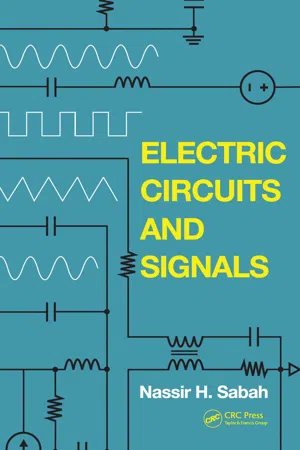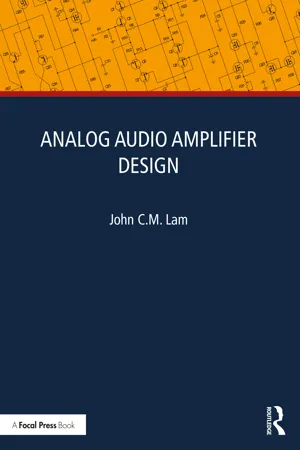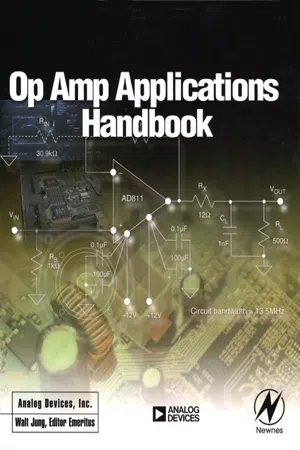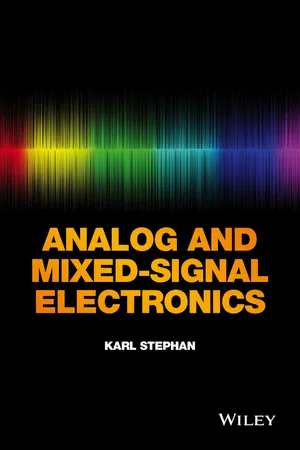Physics
Linear Op Amp
A linear operational amplifier (op-amp) is a type of electronic amplifier that produces an output that is proportional to the input signal. It is designed to have a linear response, meaning that the output varies in direct proportion to the input. Op-amps are commonly used in a wide range of electronic applications, including signal processing and control systems.
Written by Perlego with AI-assistance
Related key terms
Related key terms
1 of 4
Related key terms
1 of 3
11 Key excerpts on "Linear Op Amp"
- eBook - ePub
- Nassir H. Sabah(Author)
- 2017(Publication Date)
- CRC Press(Publisher)
18Signal Processing Using Operational Amplifiers
Overview
An operational amplifier, or op amp for short, is a high-gain voltage amplifier, designed to amplify signals in the frequency range from dc to a specified upper frequency. Operational amplifiers are so called because they were initially introduced to perform mathematical operations — such as addition, subtraction, differentiation, and integration — in analog computers that were commonly used to solve differential equations, before digital computers prevailed. Nowadays, op amps of high performance and low cost are widely available in integrated-circuit (IC) form, which makes them an important building block in a variety of signal-processing applications. A number of these applications are considered in this chapter.The most important feature of Linear Op Amp circuits is the use of negative feedback to trade-off the high gain of the op amp for some desirable feature, thereby allowing such operations as precision amplification and integration. Op amps are at the heart of active filters of various types, whose performance is superior in many respects to that of passive filters, particularly in their allowing high Q - eBook - ePub
Introduction to Energy, Renewable Energy and Electrical Engineering
Essentials for Engineering Science (STEM) Professionals and Students
- Ewald F. Fuchs, Heidi A. Fuchs(Authors)
- 2020(Publication Date)
- Wiley(Publisher)
8 Operational Amplifiers8.1 Introduction
The operational (OP) amplifier is a basic building block for the design of analog electronic systems such as feedback control circuits [1 ], where the angular velocity ω m (t), angular position θ m (t) = ∫ω m (t)dt, current i(t), and torque T(t) must be controlled. An OP amplifier with no external circuitry is a voltage amplifier with a very high open‐loop voltage gain that ideally approaches infinity A v → ∞, as shown in a symbolic manner in Figure 8.1 . Note that input/output voltages can be either time varying or time independent, and they can be either periodic or nonperiodic.OP amplifiers are integrated circuits (IC), which can be purchased off the shelf, and they contain transistors, diodes, resistors, and capacitors all fabricated on a single silicon chip. Inductors are bulky and are mostly avoided in OP amplifier designs. The analog electronic circuit of Figure 8.1 has two inputs: a negative (v − ) and a positive (v + ) input supplied by the voltages v in1 and v in2 , respectively, whose difference in voltage (v in2 − v in1 ) produces an output signal voltage v out that is a replica of the input voltage difference. The two‐input voltage approach is useful because stray signals/electric noise that appear on both inputs are cancelled, and only the voltage difference is amplified. An OP amplifier is also called a differential amplifier because the output voltage is a voltage that is A v times the voltage difference between the two inputs. During the past half century, OP amplifiers have been refined and improved to the extent that they have nearly ideal properties, and therefore we discuss in this textbook the performance of ideal OP amplifiers only. The understanding of nonideal properties of OP amplifiers requires detailed electronic knowledge [2 - eBook - ePub
- John C.M. Lam(Author)
- 2024(Publication Date)
- Focal Press(Publisher)
4Operational amplifiersDOI: 10.4324/9781003369462-44.1 Introduction
Figure 4.1 shows a diagram of an operational amplifier, which is often called an op-amp. An opamp has two inputs (inverted and non-inverted), one output, and dual power supply terminals. Some op-amps also offer two more terminals for connecting a trimmer to reduce dc offset voltage. Op-amp is a versatile electronic device that is found in almost every electronic application. A good understanding of op-amp and its applications is essential to perform the design work for audio and linear application.Diagram of an operational amplifier (op-amp)Figure4.1An ideal op-amp has the following properties [1 –3 ]:- infinite differential voltage gain;
- infinite input impedance;
- zero output impedance;
- zero input offset voltage;
- zero input bias current.
Therefore, the differential inputs of an ideal op-amp must be zero, i.e., V+ ‒ V- = 0, and the input current is also zero, i.e., I+ = 0, I- = 0. We can easily see why these must be true. If Av denotes the differential voltage gain of the op-amp, the output is given asVout =(V+-V-)AvFrom a mathematical point of view, if the differential voltage gain Av approaches infinite, the output will also approach infinite. In order to confine the output to a finite value for practical use, the term (V+ ‒ V-) must be zero. In other words, the non-inverted input and inverted input must be equal at all times, V+ = V-. On the other hand, since the input impedance is infinite, it can be easily understood that the input current must be zero, I+ = 0 and I- = 0. These properties lead to the so-called golden rules for op-amp application analysis:- non-inverted and inverted inputs are equal at all times, V+ = V-
- zero input current at all times, I+ = 0 and I- = 0
Even though an ideal op-amp does not exist in real life, the golden rules help tremendously to simplify the op-amp application analysis. After all, the results that are determined by applying the golden rules are sufficiently accurate for almost all applications. In the following, some audio and linear applications using an op-amp are discussed. - eBook - ePub
Linear Feedback Controls
The Essentials
- Mark A. Haidekker(Author)
- 2020(Publication Date)
- Elsevier(Publisher)
Fig. 14.1 shows the schematic symbol of an op-amp and its block diagram, which allows an interpretation of its function.Figure 14.1 (A) Schematic symbol of the operational amplifier. (B) Functional block diagram. The ideal operational amplifier multiplies the difference of the input signals by a large real-valued gain factor G(s)=g, where g is typically between 104 and 106 , depending on the type of operational amplifier. The input current is considered to be negligible.Operational amplifiers are relatively complex devices with easily 20–30 transistors per unit. Op-amps consist of an input difference stage, a gain stage, and the output driver. Various simplified mathematical models can be used to approximate their behavior. In the simplest model the voltage difference between the inputs is multiplied by a large real-valued gain factor g, and the op-amp acts as a voltage-controlled voltage source with a gain between 104 and 106 . This gain is commonly referred to as differential gain, because it amplifies the voltage difference between the positive and negative inputs. Furthermore, input currents are considered to be zero in an ideal operational amplifier, that is, an infinite input impedance is assumed. Finally, any output offset is considered to be negligible, and the output impedance is taken as zero. For low frequencies up to several kHz, the zero-order model of real-valued gain g is sufficiently accurate. However, the gain decreases with increasing input frequency, and for frequencies in the high kHz range and above, a higher-order transfer function needs to be used.Electronic circuits with high gain tend to be unstable and oscillate. For this reason, most general-purpose op-amps come with a built-in compensation network to make them appear like a stable first-order time-lag system in a wide frequency range, and the op-amp pole is usually placed between 10 and 100Hz. At much higher frequencies, typically far above 100kHz, the gain drops rapidly due to internal delays. When the op-amp is used in a feedback configuration with a closed-loop gain much smaller than the native op-amp gain, the first-order model of the open-loop gain, - eBook - ePub
- Walt Jung(Author)
- 2004(Publication Date)
- Newnes(Publisher)
specifications are also discussed, along with those specification differences that occur between the broad distinctions of voltage or current feedback topologies, as well as the more detailed context of individual structures. Obviously, op amp specifications are also application drivers; in fact, they are the most important since they will determine system performance. We choose the best op amp to fit the application, based on the required bias current, bandwidth, distortion, and so forth.Passage contains an image SECTION 1-1
Introduction
Walt JungAs a precursor to more detailed sections following, this introductory chapter portion considers the most basic points of op amp operation. These initial discussions are oriented around the more fundamental levels of op amp applications. They include: Ideal Op Amp Attributes, Standard Op Amp Feedback Hookups, The Non-Ideal Op Amp, Op Amp Common-Mode Dynamic Range(s), the various Functionality Differences of Single and Dual-Supply Operation, and the Device Selection process.Before op amp applications can be developed, some requirements are in order. These include an understanding of how the fundamental op amp operating modes differ, and whether dual-supply or single-supply device functionality better suits the system under consideration. Given this, then device selection can begin and an application developed.First, an operational amplifier (hereafter simply op amp) is a differential input, single-ended output amplifier, as shown symbolically in Figure 1-1 . This device is an amplifier intended for use with external feedback elements, where these elements determine the resultant function, or operation. This gives rise to the name “operational amplifier,” denoting an amplifier that, by virtue of different feedback hookups, can perform a variety of operations.1 At this point, note that there is no need for concern with any actual technology to implement the amplifier. Attention is focused more on the behavioral nature of this building block device.Figure 1-1 The ideal op amp and its attributesAn op amp processes small, differential mode signals appearing between its two inputs, developing a single-ended output signal referred to a power supply common terminal. Summaries of the various ideal op amp attributes are given in Figure 1-1 - eBook - ePub
- Analog Devices Inc. Analog Devices Inc. Engineeri, Hank Zumbahlen(Authors)
- 2011(Publication Date)
- Newnes(Publisher)
CHAPTER 1 The Op AmpSection 1-1: Op Amp OperationSection 1-2: Op Amp SpecificationsSection 1-3: How to Read a Data SheetSection 1-4: Choosing an Op AmpChapter Introduction
In this chapter we will discuss the basic operation of the op amp, one of the most common linear design building blocks.In Section 1-1 the basic operation of the op amp will be discussed. We will concentrate on the op amp from the black box point of view. There are a good many texts that describe the internal workings of an op amp, so in this work a more macro view will be taken. There are a couple of times, however, that we will talk about the insides of the op amp. It is unavoidable.In Section 1-2 the basic specifications will be discussed. Some techniques to compensate for some of the op amps limitations will also be given.Section 1-3 will discuss how to read a data sheet. The various sections of the data sheet and how to interpret what is written will be discussed.Section 1-4 will discuss how to select an op amp for a given application.SECTION 1-1 Op Amp Operation
Introduction
The op amp is one of the basic building blocks of linear design. In its classic form it consists of two input terminals—one of which inverts the phase of the signal, the other preserves the phase—and an output terminal. The standard symbol for the op amp is given in Figure 1-1 . This ignores the power supply terminals, which are obviously required for operation.Figure 1-1: Standard op amp symbolThe name “op amp” is the standard abbreviation for operational amplifier. This name comes from the early days of amplifier design, when the op amp was used in analog computers. (Yes, the first computers were analog in nature, rather than digital.) When the basic amplifier was used with a few external components, various mathematical “operations” could be performed. One of the primary uses of analog computers was during World War II, when they were used for plotting ordinance trajectories. - David Terrell(Author)
- 1996(Publication Date)
- Newnes(Publisher)
Op amps are used to amplify signals that range from DC through the higher radio frequencies (RF). The amplifier can be made to be frequency selective (i.e., act as a filter) much like the tone control on your favorite stereo system. It may be used to maintain a constant output in spite of changing input levels. The output can produce a compressed version of the input to reduce the range needed to represent a certain signal. The amplifier may respond to microvolt signals originating in a transducer, which is used to measure temperature, pressure, density, acceleration, and so on. The gain of the amplifier can be controlled by a digital computer, thus extending the power of the computer into the analog world.Oscillators.
The basic op amp can be connected to operate as an oscillator. The output of the oscillator may be sinusoidal, square, triangular, rectangular, sawtooth, exponential, or other shape. The frequency of oscillation may be stabilized by a crystal or controlled by a voltage or current from another circuit.Regulators.
Op amps can be used to improve the regulation in power supplies. The actual output voltage is compared to a reference voltage and the difference is amplified by an op amp and used to correct the power supply output voltage. Op amps can also be connected to regulate and/or limit the current in a power supply.Rectification.
Suppose you want to build a half-wave rectifier with a peak input signal of 150 millivolts. This is not enough to forward bias a standard silicon diode. On the other hand, an op amp can be configured to provide the characteristics of an ideal diode with 0 forward voltage drop. Thus it can rectify very small signals.Computer Interfaces.
The op amp is an integral part of many circuits used to convert analog signals representing real-world quantities (such as temperature, RPM, pressure, and so forth) into corresponding digital signals that can be manipulated by a computer. Similarly, the op amp is frequently used to convert the digital output of a computer into an equivalent analog form for use by industrial devices (such as motors, lights, and solenoids).Fields of Application.
Op amps find use in such diverse fields as medical electronics, industrial electronics, agriculture, test equipment, consumer products, and automotive products. It has become a basic building block for analog systems and for the analog portion of digital systems.- Robert B. Northrop(Author)
- 2012(Publication Date)
- CRC Press(Publisher)
6 Operational Amplifiers and Comparators6.1 IDEAL OP AMP
6.1.1 Introduction
The operational amplifier (op amp) had its origins back in the 1940–1960 era of electronics where its principal use was as an active element in analog computer systems. Early op amp circuits used vacuum tubes; op amps were used as summers, subtractors, integrators, filters, etc. in analog computer systems designed to model dynamic, electromechanical feedback systems such as autopilots, bombsights, and motor speed controls. With the rise of digital computers in the 1960s, analog computers were largely replaced for simulations by digital computers using software numerical methods such as IBM’s CSMP™, also Tutsim™, Simnon™, MATLAB™, etc. However, electrical engineers found that the basic linear and nonLinear Op Amp building blocks could be used for analog signal conditioning in other systems. With the advent of semiconductors, op amps were designed with transistors as gain elements, instead of bulky vacuum tubes. The next step, of course, was to design integrated circuit (IC) op amps, one of the first of which was the venerable (but now obsolete) LM741. (Why, you might ask, is the LM741 obsolete? Newer op amps with better gain-bandwidth products have lower DC bias currents (IB and IB ′), lower DC offset voltages (VOS ) and VOS tempco, lower noise, higher DC gains, higher CMRRs, higher Zin s, etc., and are often less expensive.)At present, operational amplifiers (op amps) are used for a wide spectrum of linear biomedical signal conditioning applications, including differential instrumentation amplifiers, electrometer amplifiers, low-drift DC signal conditioning, active filters, summers, etc. NonLinear Op Amp applications have expanded to include true-RMS to DC conversion, precision rectifiers, phase-sensitive rectifiers, peak detectors, log converters,- eBook - ePub
- Peter Wilson(Author)
- 2017(Publication Date)
- Newnes(Publisher)
Chapter 5Analog Integrated Circuits
Abstract
The operational amplifier is the basic building block for analog circuits, and progress in op-amp performance is the “litmus test” for linear IC technology in much the same way as progress in memory devices is for digital technology. This chapter will be devoted to op-amps and comparators, with a tailpiece on voltage references. Volumes have already been written about op-amp theory and circuit design, and these aspects will not be repeated here. Rather, we shall take a look at the departures from the ideal op-amp parameters that are found in practical devices and survey the trade-offs—including cost and availability, as well as technical factors—that have to be made in real designs. Some instances of anomalous behavior will also be examined.Keywords
Band-gap reference; Noise analysis; Op-amps; Slew rate; Stray feedback; Totem poleChapter Outline5.1 The Ideal Op-Amp 5.1.1 Applications Categories 5.2 The Practical Op-Amp 5.2.1 Offset Voltage Output Saturation Due to Amplified Offset Reducing the Effect of Offset Offset Drift Circuit Techniques to Remove the Effect of Drift 5.2.2 Bias and Offset Currents Bias Current Levels Output Offsets Due to Bias and Offset Currents 5.2.3 Common-Mode Effects Common-Mode Rejection Ratio Power Supply Rejection Ratio 5.2.4 Input Voltage Range Absolute Maximum Input 5.2.5 Output Parameters Power Rail Voltage Load Impedance 5.2.6 AC Parameters 5.2.7 Slew Rate and Large-Signal Bandwidth Slew Rate Large-Signal Bandwidth Slewing Distortion 5.2.8 Small-Signal Bandwidth 5.2.9 Settling Time 5.2.10 The Oscillating Amplifier Ground Coupling Power Supply Coupling Output-Stage Instability Stray Capacitance at the Input Parasitic Feedback 5.2.11 Open-Loop GainSagging A OL5.2.12 Noise - eBook - ePub
- Karl Stephan(Author)
- 2015(Publication Date)
- Wiley(Publisher)
FB , the 3-dB-down frequency with feedback. But if you devise a new design, it will be your responsibility to check and make sure this condition is valid.5.3.1 Linear Op Amp Circuits
With due attention to gain and bandwidth limitations, we will now describe a number of Linear Op Amp circuits in common use and will employ the approximation of Equation 5.11 in calculating their transfer functions. But the designer should remember the conditions under which the approximation is valid and make sure these conditions are met in a given application.5.3.1.1 Voltage Follower
The simplest Linear Op Amp circuit is a voltage follower, whose name derives from the fact that the output voltage follows the input voltage almost exactly. When the feedback factor β is 1, Equation 5.11 implies that the circuit’s transfer function is H = 1 also. Figure 5.6 shows the diagram of a voltage follower using an op amp and indicates that the output of the op amp is connected directly to the inverting input. We have adopted a simplified schematic symbol for the op amp in Figure 5.5 , denoting the inverting and noninverting inputs by the symbols − and +, respectively, and omitting the power-supply connections. However, the reader must remember when actually building such circuits that all op amps need power supplies, whether or not the connections are explicitly shown.Voltage-follower circuit using op amp.Figure 5.6The usefulness of an amplifier circuit with a gain of 1 is not perhaps immediately obvious. The voltage-follower circuit is sometimes called a buffer, because it isolates any circuit connected to its input from loading effects of a low-impedance load. For an example of this, we show a simple voltage-follower application in Figure 5.7 : a buffer preamp for a condenser microphone - eBook - ePub
- Darren Ashby, Bonnie Baker, Ian Hickman, Walt Kester, Robert Pease, Tim Williams, Bob Zeidman(Authors)
- 2011(Publication Date)
- Newnes(Publisher)
Chapter 19
Op-Amps
Darren Ashby, Bruce Carter, Ron Mancini, Tim Williams and Bonnie Baker19.1 The Magical Mysterious Op-Amp
An operational amplifier, often called an op-amp , in my opinion, are probably the misunderstood, yet potentially useful IC at the engineer’s disposal. It makes sense that if you can understand this device you can put it to use, giving you a great advantage in designing successful products.19.1.1 What is an Op-Amp Really?
Do you understand how an op-amp works? Would you believe that op-amps were designed to make it easier to create a circuit? You probably didn’t think that the last time you were puzzling over a misbehaving breadboard in the lab.In today’s digital world, it seems to be common practice to breeze over the topic of op-amps giving the student a dusting of commonly used formulas without really explaining the purpose or theory behind them. Then, the first time an engineer designs an op-amp circuit, the result is utter confusion when the circuit doesn’t work as expected. This discussion is intended to give some insight into the guts of an operational amplifier, and to give the reader an intuitive understanding of op-amps.One last point—make sure you read this section first! It is my opinion that one of the causes of op-fusion (op-amp confusion) as I like to call it, is that the theory is taught out of order. There is a very specific order to this, so please understand each section before moving on.First, let’s take the symbol of an op-amp (Figure 19.1 ).There are two inputs, one positive and one negative, identified by the + and − signs. There is one output.Figure 19.1 Your basic op-ampThe inputs are high impedance. I repeat. The inputs are high impedance. Let me say that one more time. THE INPUTS ARE HIGH IMPEDANCE! This means they have (virtually) no effect on the circuit to which they are attached. Write this down, as it is very important. We will talk about this in more detail later. This important fact is commonly forgotten and contributes to the confusion I mentioned earlier.
Index pages curate the most relevant extracts from our library of academic textbooks. They’ve been created using an in-house natural language model (NLM), each adding context and meaning to key research topics.
Explore more topic indexes
Explore more topic indexes
1 of 6
Explore more topic indexes
1 of 4










